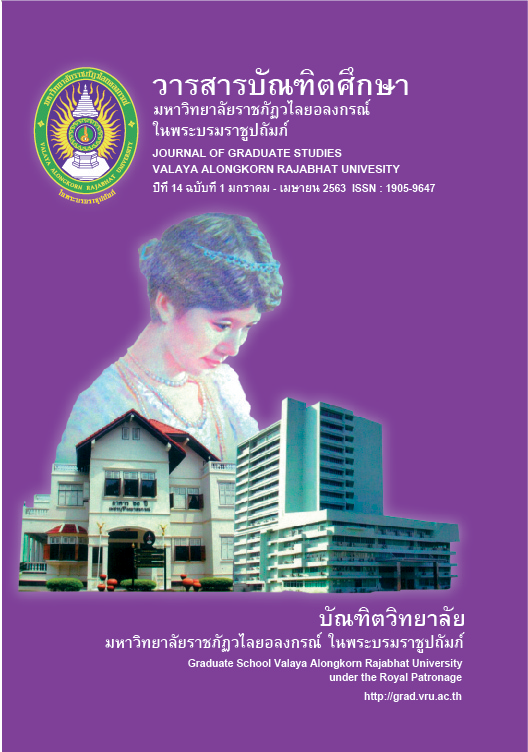THE APPLICATION OF GAMES IN LEARNING MANAGEMENT IN PHYSICAL EDUCATION
Main Article Content
Abstract
The teaching and learning of games and sport-based activities has been a main form of physical education. Teaching games for students to understand the rules and concept can be highlighted as a Student-Centered Approach. Teacher choose content which can be further developed and managed in the class so that the students have more opportunities to respond, get involved cognitively and make decisions about the game. The independent variable is the lesson structure and dependent variables are the learning means. The game presents a problem that students must face and allows students to apply their knowledge from practice, game sense, tactical problem solving, declarative knowledge, enjoyment, motivation and developing leadership skills. These proposals are based on situated learning, with meaningful and contextualized situations that favor students’ learning.
Article Details
บทความทุกเรื่องได้รับการตรวจความถูกต้องทางวิชาการโดยผู้ทรงคุณวุฒิ ทรรศนะและข้อคิดเห็นในบทความวารสารบัณฑิตศึกษา มหาวิทยาลัยราชภัฏวไลยอลงกรณ์ ในพระบรมราชูปถัมภ์ มิใช่เป็นทรรศนะและความคิดของผู้จัดทำจึงมิใช่ความรับผิดชอบของบัณฑิตวิทยาลัย มหาวิทยาลัยราชภัฏวไลยอลงกรณ์ ในพระบรมราชูปถัมภ์ กองบรรณาธิการไม่สงวนสิทธิ์การคัดลอก แต่ให้อ้างอิงแหล่งที่มา
References
Chatzipanteli, A. (2014). A tactical-game approach and enhancement of metacognitive behaviour in elementary school students. Physical Education and Sport Pedagogy, 21(2), 1-16.
Inlakorn, S. (2011). Thēknikwithīkān lænawatkam thīchaičhatkitkamkānrīankānsō̜n thīnēnnakrīanpensūnklāng [Techniques, methods, and innovations used to organize student-centered teaching and learning activities]. Ubonratchathani: UbonKit Offset Printing.
Kulthawatwichai, T. (2011). Kānnanthanākān [Recreation]. Bangkok: Publisher of Chulalongkorn University.
Kuna-apisit, W. (1996). Kānsō̜nphonlasưksā [Physical Education Teaching]. Company pimdee.
Panakul, S. et al. (2013). Laksūtlækānčhatkānrīanrū [Curriculum and Learning Management]. 3rd edition. Publisher of Ramkhamhaeng University.
Pianchob, T. (2018). Rūambotkhwāmkīaokappradchaya lakkān withīsō̜nlækānwat phư̄apramœ̄nphonthāngphonlasưksā [Collection of articles about philosophy, principles, teaching methods, and measurement for assessment in physical education]. Bangkok: Publisher of Chulalongkorn University.
Poompak, C. et al. (2009). Khūmư̄khrū phǣnkānčhatkānrīanrū klumsārakānrīanrū suksưksālæphonlasưksā tāmlaksūtkǣnklāngkānsưksānaphư̄nthān phutthasakrāt sō̜ngphanhārō̜ihāsipʻet [Teacher Manual, Learning Management Plan, Health Education and Physical Education According to the core curriculum of basic education, 2008]. Bangkok: Thaiwattanapanich Printing Co., Ltd.
Soonchan, R. (2018). Phonlakārotʻonyimnātsatik dūaiwithīsō̜nbǣpthēktikkhō̜n tāmkānraprūkhō̜ngphūrīan [The effect of gymnastics teaching by using tactics as perceived by students]. Institute of Physical Education Chaiyaphum Campus.
Sports Authority of Thailand. (2007). Laksūtphūfưksō̜nkīlāfandāpradapsūng [Advanced Fencing Trainer Course]. Bangkok: Drokbia Printing house.
Supaporn, S. (2013). Phonkrathopkhō̜ngkānsō̜nthēnnit dūaiwithīsō̜n bǣpthǣktikhō̜n lækānsō̜nbǣpdōitrong [The impact of learning tennis through tactical game approach and direct teaching]. Journal of Faculty of Physical Education, 16(1), 20-34.


